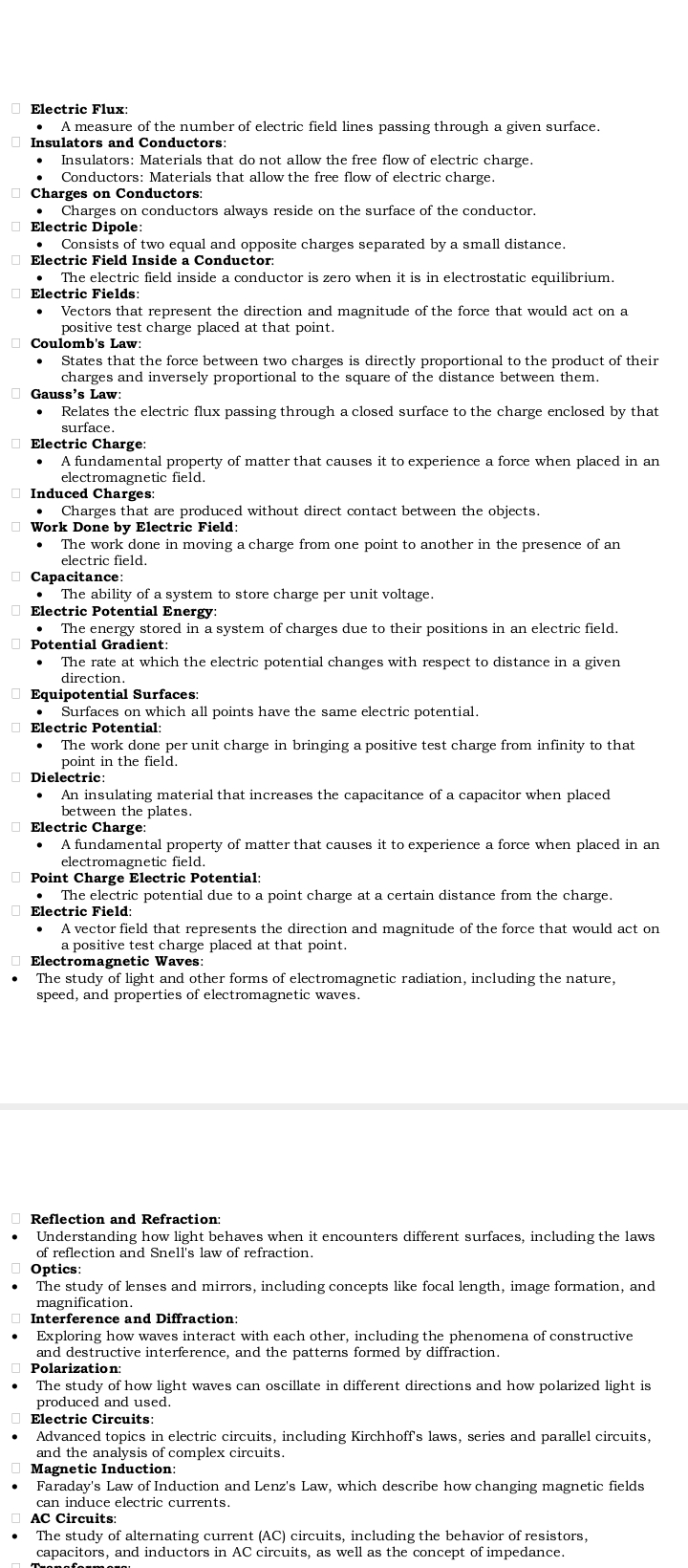Definitions and concepts related to electricity, electromagnetism, and optics.

Understand the Problem
The image presents a list of definitions and concepts related to electricity, electromagnetism, and optics. It covers fundamental principles like electric flux, Coulomb's law, and electric fields, as well as more advanced topics such as AC circuits, magnetic induction, and wave phenomena. The question is likely asking for one of these definitions.
Answer
Key concepts include electric flux, insulators, conductors, electric dipole, electric fields, Coulomb's Law, Gauss's Law, electric charge, capacitance, electric potential, dielectrics, electromagnetic waves, optics, and magnetic induction.
Here are some definitions and concepts related to electricity, electromagnetism and optics:
- Electric Flux: A measure of the number of electric field lines passing through a given surface.
- Insulators: Materials that do not allow the free flow of electric charge.
- Conductors: Materials that allow the free flow of electric charge.
- Electric Dipole: Consists of two equal and opposite charges separated by a small distance.
- Electric Fields: Vectors that represent the direction and magnitude of the force that would act on a positive test charge placed at that point.
- Coulomb's Law: States that the force between two charges is directly proportional to the product of their charges and inversely proportional to the square of the distance between them.
- Gauss's Law: Relates the electric flux passing through a closed surface to the charge enclosed by that surface.
- Electric Charge: A fundamental property of matter that causes it to experience a force when placed in an electromagnetic field.
- Capacitance: The ability of a system to store charge per unit voltage.
- Electric Potential: The work done per unit charge in bringing a positive test charge from infinity to that point in the field.
- Dielectric: An insulating material that increases the capacitance of a capacitor when placed between the plates.
- Electromagnetic Waves: The study of light and other forms of electromagnetic radiation, including the nature, speed, and properties of electromagnetic waves.
- Optics: The study of lenses and mirrors, including concepts like focal length, image formation, and magnification.
- Magnetic Induction: Faraday's Law of Induction and Lenz's Law, which describe how changing magnetic fields can induce electric currents.
Answer for screen readers
Here are some definitions and concepts related to electricity, electromagnetism and optics:
- Electric Flux: A measure of the number of electric field lines passing through a given surface.
- Insulators: Materials that do not allow the free flow of electric charge.
- Conductors: Materials that allow the free flow of electric charge.
- Electric Dipole: Consists of two equal and opposite charges separated by a small distance.
- Electric Fields: Vectors that represent the direction and magnitude of the force that would act on a positive test charge placed at that point.
- Coulomb's Law: States that the force between two charges is directly proportional to the product of their charges and inversely proportional to the square of the distance between them.
- Gauss's Law: Relates the electric flux passing through a closed surface to the charge enclosed by that surface.
- Electric Charge: A fundamental property of matter that causes it to experience a force when placed in an electromagnetic field.
- Capacitance: The ability of a system to store charge per unit voltage.
- Electric Potential: The work done per unit charge in bringing a positive test charge from infinity to that point in the field.
- Dielectric: An insulating material that increases the capacitance of a capacitor when placed between the plates.
- Electromagnetic Waves: The study of light and other forms of electromagnetic radiation, including the nature, speed, and properties of electromagnetic waves.
- Optics: The study of lenses and mirrors, including concepts like focal length, image formation, and magnification.
- Magnetic Induction: Faraday's Law of Induction and Lenz's Law, which describe how changing magnetic fields can induce electric currents.
More Information
Electromagnetism is the physical interaction among electric charges, magnetic moments, and electromagnetic fields. An electromagnetic field can be static, slowly changing, or form waves. Electromagnetic waves are generally known as light and obey the laws of optics.
Tips
Ensure to differentiate between the terms, understanding that each describes a unique aspect of electrical, magnetic, or optical phenomena.
Sources
- Electromagnetism - Wikipedia - en.wikipedia.org
- Electromagnetism and Light | Physics - Visionlearning - visionlearning.com
- Electromagnetism - Definition, Examples | Electromagnetic Force - BYJU'S - byjus.com
AI-generated content may contain errors. Please verify critical information